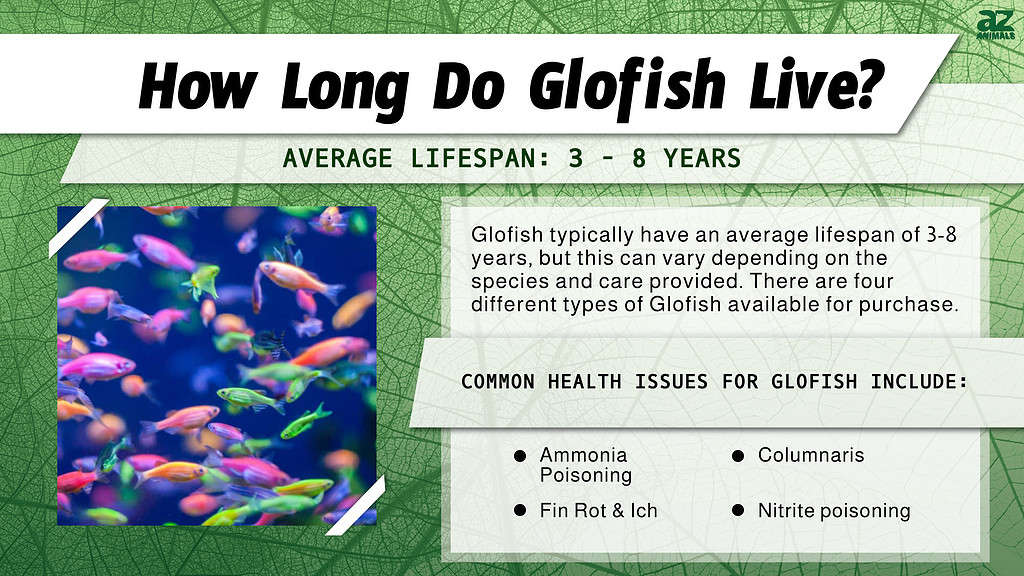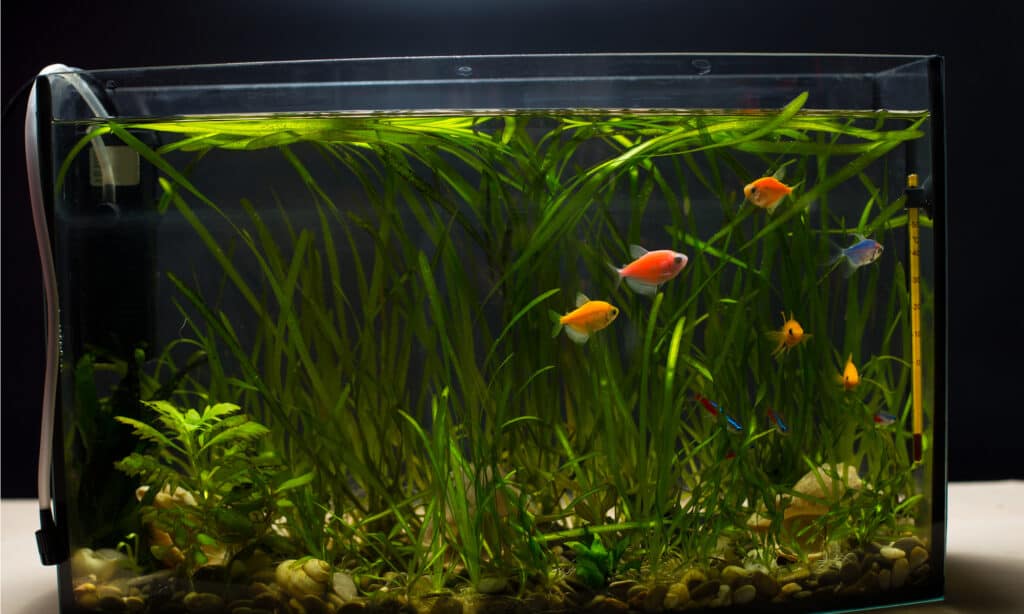
The Glofish is a genetically produced luminous fish that has been registered and trademarked. So what exactly does that mean? It means that these fish swim around while emitting a gorgeous, vibrant color. Glofish are not colored or injected with colors either. They have all been genetically engineered with the fluorescent gene, which allows them to be so colorful. They were initially designed to serve as markers of water contamination.
Are you curious to learn more about this beautifully colored fish that would be a great addition to your aquarium? If so, then we’ve got the rundown for you. Learn all about the Glofish lifespan and other fun facts!
How Long Do Glofish Live?

Glofish have an average lifespan of 3-8 years.
©Varvara Voinarovska/Shutterstock.com
The average Glofish lifespan is 3-8 years; however, this varies based on the species and care they receive. There are four types of Glofish available for purchase.
Let’s take a look at the lifespan of each species of Glofish:
- Glofish Barbs: The Glofish barbs live for about 4-7 years. These fish come in vibrant green, red, purple, and orange hues. The hues are emphasized even further by their thick black stripes.
- Glofish Tetras: Glofish tetras have a lifespan of 3-5 years. If kept under ideal environmental circumstances, they can live for more than five years. Tetras come in a variety of stunning hues, including cosmic blue, galaxy purple, moonrise pink, and sunburst orange.
- Glofish Danios: The Glofish danios have a lifespan of about 5 years. These energetic swimmers are available in five stunning colors: electric green, cosmic blue, Starfire red, sunburst orange, and galaxy purple.
- Glofish Rainbow Sharks: The Glofish sharks actually enjoy the longest lifespan of all the species. They can typically live up to 8 years. Glofish rainbow sharks are available in three stunning colors: blue, purple, and orange.
Now that we know how long each species of Glofish live, let’s look at their incredible life cycle stages.
The Average Glofish Life Cycle

Female Glofish lay eggs for the males to fertilize.
©snoymonkey/Shutterstock.com
As mentioned earlier, Glofish are zebra danio fish that have been genetically modified to be bioluminescent. These days, Glofish is capable of reproducing without the help of scientists. Let’s take a look at how these colorful fish reproduce so you can know what to expect in your aquarium!
Courtship and Eggs
A female Glofish emits pheromones that cause the male to start courting activity. The male emits gonadal pheromones, prompting the female to ovulate. Female Glofish are capable of laying eggs every two to three days. A single clutch might include hundreds of eggs.
Gestation Period
Females will exhibit physical symptoms that they are pregnant. The most noticeable sign is a bloated abdomen. Many pet owners confuse abdominal swelling with pregnancy. Glofish do not have live births and hence cannot technically be called pregnant. In the presence of males, females will lay eggs.
Fertilization of Eggs
Female Glofish lay their eggs in the water, generally at a spawning spot or while they swim around their fish tank. Males fertilize the eggs as they sink to the bottom of the tank after the female releases them into the water. Many males can fertilize eggs from a single female.
Hatching
Fertilized eggs have a low chance of survival. The adult Glofish consumes the majority of them practically immediately. Many fish owners place marbles at the bottom of their fish tanks to preserve the fertilized eggs. The marbles allow little holes for the fertilized eggs to bounce or slide into, protecting them. It can take up to two days for the eggs to hatch and then another two to three days for the fry to swim out in search of food.
Factors That Impact The Glofish Lifespan
When it comes to Glofish, one of the most important factors influencing lifetime is the water conditions. Above all, the quality and cleanliness of your water will affect how long your fish will survive. Unclean water, for example, can become poisonous due to excessive amounts of Ammonia, Nitrites, and Nitrates, all of which are highly hazardous to your fish.
Dirty water may also cause a variety of additional issues, including stress, infections, and sickness. All of these will have a negative influence on the general health of your fish and significantly limit its lifetime.
We’ll go in-depth about how you can assist your fish to live a long and happy life below, but first, here are a few more factors that might affect how long your Glofish lives.
These factors are:
- Tank size
- The temperature of the water
- Water parameters
- Tankmates
- Oxygenation
- Maintenance schedule
- Diet
Now that we know all the factors that can negatively impact your Glofish lifespan, let’s see about all the things we can do to help them live a healthy life.
How To Extend The Life Of Your Glofish

Maintaining good water quality is essential for keeping your Glofish healthy.
©Sergiy Akhundov/Shutterstock.com
As previously said, there are several things you can do to assist your pet fish’s life and guarantee it is as long as possible.
The best tips for extending your Glofish’s lifespan are:
- Choose the Correct Tank Size: When fish are kept in tanks that are too tiny for them to grow or swim in, they might develop a variety of health issues such as deformities, undeveloped muscles, spinal difficulties, and stress. Furthermore, if you have a lot of fish in a small tank, fish who are not normally violent will battle for space and become territorial.
- Proper Water Parameters: Fish produce waste, which settles at the bottom of the tank and slowly degrades into ammonia, nitrites, and, finally, nitrates. This is known as the nitrogen cycle, and it occurs continually in every tank. If you don’t replace your water regularly, these poisons can accumulate in the water column and cause your fish to die slowly.
- Keeping Optimal Temperature of Tank: Another crucial aspect that you will need to maintain is the temperature of your tank. A heater and a thermometer are required to control the temperature of your tank. A good temperature range is one that is comfortable for most of the fish in your tank. Use a thermometer to monitor the temperature regularly.
The photo featured at the top of this post is © snoymonkey/Shutterstock.com
Thank you for reading! Have some feedback for us? Contact the AZ Animals editorial team.






